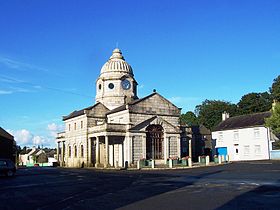- Massacre of Dunlavin Green
-
Dunlavin Green Massacre Location Dunlavin, County Wicklow Date 25 May 1798 Attack type Firing squad Death(s) 36 Injured 3 Perpetrator  British Army
British ArmyThe Massacre of Dunlavin Green refers to the summary execution of 36 suspected rebel prisoners by the British military shortly after the outbreak of the rebellion of 1798. There are several accounts of the events, recorded at differing times and differing in detail.
Contents
Background
For several months prior to May 1798, county Wicklow and many other areas of the country had been subject to martial law which had been imposed in an effort to crush the long threatened rebellion of the United Irishmen. The campaign was also extended against the military itself as some corps of yeomen and militia, especially those with Catholic members, were suspected as United Irish infiltrators who had joined to get training and arms. Several days before the outbreak of the rebellion, the yeomanry and militia at Dunlavin were called out on parade and informed by their commanding officer that it had been brought to his attention that there were sworn United Irishmen among them. Urging those who had sworn to confess, some twenty-eight did so in hopes of receiving clemency but were immediately arrested and imprisoned with several subjected to flogging in an effort to extract information about the rebels plans and organisation.[1][2][3][4]
One loyalist account of events leading up to the execution is the only to give a different sequence of events[5]. According to this, Captain Ryves, a military commander at Dunlavin received word that a large number of rebels were to attack Dunlavin and he observed that many Protestant houses had been set on fire in the surrounding countryside. In the circumstances, he expected that the rebels' intention was a pogrom of Protestants and Loyalists in the town and district. A foray by the troops into the countryside failed and the garrison's officers were aware that they were outnumbered by the prisoners held in the Market House. The account is largely dismissed and is the only loyalist account of the event. The Ryves account was only published in one book.
Massacre
News of the outbreak of the rebellion had reached the garrison at Dunlavin, and particularly of an attack on Ballymore-Eustace where soldiers from the same regiment as the garrison were stationed. After hearing of losses among their comrades, the twenty-eight imprisoned soldiers and eight civilians accused of rebel sympathies were marched to the town green where they were lined up and executed in batches of five. The motive appears to have been simple revenge rather than fear of the prisoners and the raging rebellion but the public exhibition may also have been designed to intimidate and discourage rebels in the immediate area from taking to the field. However, news of the massacre, and of another at Carnew, spread rapidly and played a part in rapid mobilisation of the rebels in north county Wexford over the next few days.
An account of the execution by Reverend John F Sherman, recorded in 1866[6], which might reflect its author's allegiances, gives more detail. According to Sherman, Captain Saunders, of Stratford-on-Slaney, paraded his troops and called out those men whom he claimed were United Irishmen. Some stepped forward, but others, alerted that Saunders was in fact bluffing, denied their allegiance. Those that had stepped forward were imprisoned in the Market House at Dunlavin, to await a decision on their fates.
The following day, Captain William Ryves of Rathsallagh had his horse shot from under him while on patrol. Although he returned home safely it was decided that Saunders' imprisoned troops and others from Narraghmore, a total of 36 men, should be put to death. On May 26, market day, the 36 were taken to the green, lined up and shot in front of the townspeople, including, in some cases, their own families. The firing squad returned to the Market House where others were flogged or hanged.
Before the bodies of the shot men were removed, soldiers' wives looted them of valuables, one wounded man protested but he was finished off by a soldier. The bodies were either removed for burial by their families or interred in a common grave ("large pit") at Tournant cemetery. One man survived, despite grievous wounds, and lived to "an advanced age". Two more men, either hanging or about to be, were saved by the intervention of a "respectable Protestant" and escaped.
Commemoration
The story of the massacre at Dunlavin green was quickly commemorated in the famous ballad Dunlavin Green, which tells the story from the view of a sympathetic local eyewitness, and is one of the best known songs of the era.
In 1998, a commemorative stone was installed in St Nicholas of Myra Catholic church, adjacent to the green.
See also
- List of massacres in Ireland
- Carnew massacre
- Gibbet Rath massacre
List of battles during the rebellion
Ballymore-Eustace – Naas – Prosperous – Kilcullen – Carnew – Dunlavin – Carlow – Harrow – Tara Hill – Oulart Hill – Enniscorthy – Gibbet Rath – Newtownmountkennedy – Three Rocks – Bunclody – Tuberneering – New Ross/Scullabogue – Antrim – Arklow – Saintfield – Ballynahinch – Duncairn – Ovidstown – Foulksmills – Vinegar Hill – Ballyellis – Castlebar – Collooney – Ballinamuck – Killala – Tory IslandReferences
- ^ Northern Ireland - A Short History BBC
- ^ Dunlavin Green Mudcat Café
- ^ Kildare.ie BBC
- ^ Dunlavin Green martyrs remembered An Phoblacht
- ^ Musgrave, Richard (1802). "Memoirs of the Different Rebellions in Ireland from the Arrival of the English, p.298". http://books.google.com/books?id=kvYvAAAAMAAJ&pg=PA298&dq=dunlavin. Retrieved 5 Sep 2008.
- ^ Fitzpatrick, William John (1866). "The Rebellion in Wicklow - Fusilade in Dunlavin, pp.308-310". The 'sham squire' and the informers of 1798. http://books.google.com/books?id=d48BAAAAQAAJ&pg=PA308&dq=dunlavin. Retrieved 5 Sep 2008.
Categories:- Massacres of the Irish Rebellion of 1798
- History of County Wicklow
- Extrajudicial killings
- Massacres in Ireland
- Anti-Catholicism in Ireland
Wikimedia Foundation. 2010.

